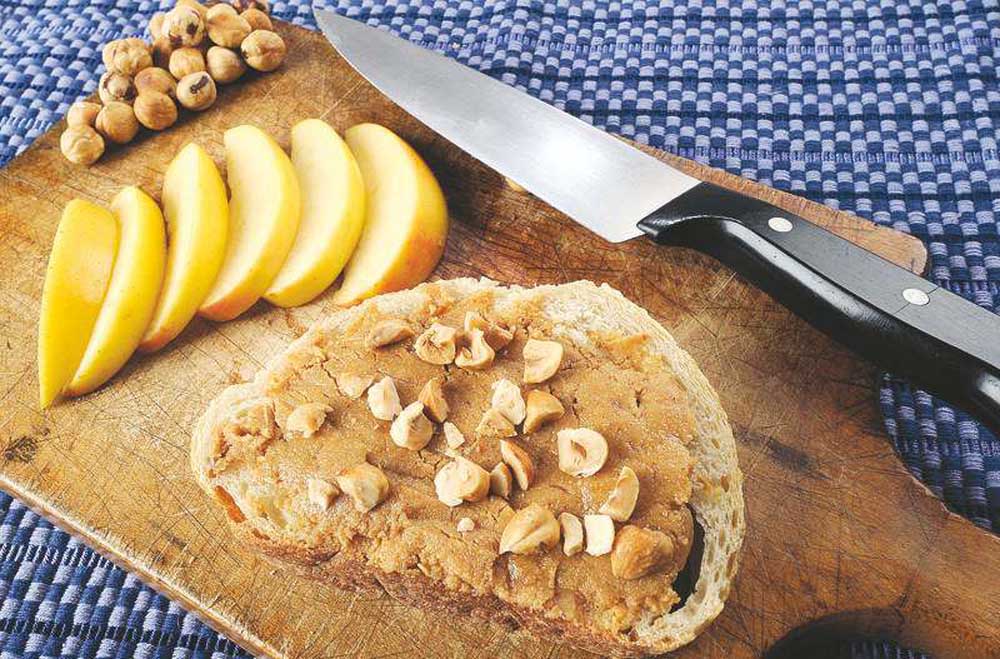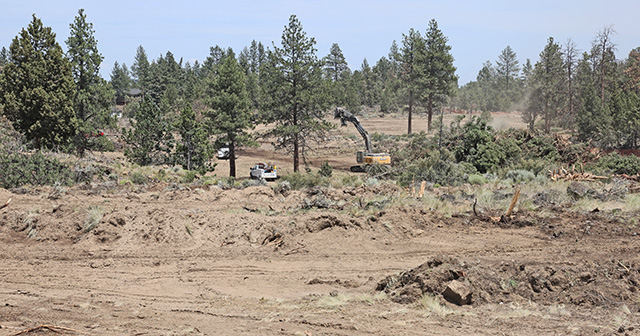Recipes: Hazelnuts ready to spread
Published 4:00 am Tuesday, November 5, 2013

- Homemade hazelnut butter stands in for peanut butter in a variety of uses, such as with bread or apple slices. You can also use homemade hazelnut butter in other recipes, such as hazelnut hummus, Page D3.
As you may or may not know, Oregon produces 99.9 percent of the domestic hazelnut crop. And most of that crop is found in the Willamette Valley, where harvest is now winding down.
The nuts had all summer to mature. They begin falling to the ground of their own accord in mid-September to early November, depending on the variety. Along the way, the orchards are meticulously cared for and groomed. Once the nuts are on the ground, they are mechanically swept into long windrows, and then scooped up with a tractor-drawn harvester and poured into large totes.
The “first pick,” as it’s called, will be the bulk of the harvest. But as autumn winds rattle the rest of the crop from the trees, growers always hope to get back through the orchard for a “second pick” as well. And sometimes even a third.
At the end of a harvest, the totes are full and the farmers are exhausted. The whole year has come down to those rows of wooden totes, each filled to the brim with 1,100 pounds of hazelnuts.
Processing
Some hazelnut farms are mechanized to the point where they can process and market their own nuts after harvest. But most growers take their totes to one of 20 major processors — they’re actually called “handlers” — in the state, where their nuts are cleaned, weighed and sampled. Once a handler determines what a given grower will be paid, based on weight and quality, the nuts are co-mingled with those of other growers for the rest of the journey through the plant.
First they’re dried, which is an exacting and tedious process. The nuts are placed in large rooms in multiple levels where the temperature is maintained at 90 to 95 degrees. Depending on the moisture within the nuts, it takes 12 to 36 hours before the nuts are down to the target moisture content of 9 percent.
From the drying chambers, the nuts scoot along through the plant on conveyor belts where they are sorted for blanks and damaged nuts. At this point, some of the nuts complete their journey to the consumer within their shells. The rest are shelled and graded by kernel size. Still more forks along the way send some of the shelled kernels straight into vacuum-sealed packages for shipping, while others will continue along to be chopped into pieces of various sizes.
It’s an exacting, exhausting process. One handler, Pat Ehli, president of P.J. Ehli Co. near Albany, puts it this way: “It’s funny how you can enjoy working a 16-hour day, seven days a week. Your growers are in and generally that’s a good thing. And you get the camaraderie and everybody’s all jacked up for harvest. So it’s fun. Not many people can go to work in the morning and really have a passion or a love for what they do. And I’ve been extremely fortunate.
“It’s always nice when it’s over, too. You can just about smell the finish line sometimes. When it’s over, it’s a very good feeling.”
As a cook, this is a great time to explore the world of hazelnuts because a fresh new crop is coming to market. For cooking, I prefer to buy shelled, whole, raw hazelnut kernels in the bulk food sections of grocery stores where I can evaluate their quality up close.
Good ones will have a rich, sweet and nutty aroma. So when you begin to scoop the nuts from the bin, pay attention. If they don’t seem fresh, let someone in the store know about it so they can replenish the bin.
Once home, I like to keep both raw and roasted kernels, prepped in various ways, in closed containers in the pantry so that when I crave a nut hit, they’re ready to go. They’re stable for at least a couple of months this way.
If you intend to squirrel away large quantities of hazelnuts, keep in mind that exposure to air, light, warmth and moisture will hasten rancidity. That makes freezing the best course. Properly packed, frozen raw hazelnuts can have a shelf life of up to 24 months.
Any treatment applied prior to freezing will reduce longevity. Roasted, whole hazelnuts tend to stay fresh in the freezer for at least 18 months; roasted and chopped, around 12 months.
Roasting
Three things happen when you roast a hazelnut: It gets more flavorful, it blushes from the inside and it takes on a pleasing crunch. So you definitely want to roast them in most cases. Another way to look at it is that roasting almost always improves how hazelnuts perform in a given recipe.
This is simple stuff, roasting hazelnuts. There is no absolute right way to do it. The pendulum swings from “low-and-slow” all the way over to “high-and-fast.” I tend to go for the middle range, 350 degrees. At that temperature, you have quite a bit of control over the outcome.
A medium roast only takes about 15 to 20 minutes. At higher temperatures, things move a bit quicker, and it’s easy to overshoot your desired endpoint.
When you begin to smell the delicious toasty aroma, it’s time to start checking the roasting progress. The longer you roast hazelnuts, the richer their flavor. You have to decide how deep of a roast you want based on how you’re planning on using them. For instance, I prefer a dark roast when combining hazelnuts with all things chocolate. It just seems to produce a more elegant flavor experience.
And apparently I’m not the only one who feels this way, since the industry standard for most candy and ice cream manufacturers is a dark roast. Here’s how to identify the various degrees of roasting:
Light roast: The skins will have cracked on the majority of the nuts, and the surface of the nut will still be a creamy ivory color. Break into one of the nuts; its center will be a slightly darker color, a sort of beige.
Medium roast: The skins will have cracked on the majority of the nuts, and the surfaces will still be a creamy-ivory color; centers will be notably darker than the surface color.
Dark roast: The skins will have darkened more and cracked on the majority of the nuts; surfaces will have darkened to a pale tan. Centers will be very dark (and getting darker faster at this point, so get those nuts out of the oven, they’re done!).
Skinning
The time-honored approach is to simply tumble a batch of roasted and cooled hazelnuts into a clean towel, fold it over and rub the nuts to remove the skins.
So while they’re fresh and spectacular, here are a few simple ways to really put the wonderful hazelnut to work in your kitchen. They all come from the cookbook I wrote on the subject back in 2010, “Oregon Hazelnut Country: The Food, the Drink, the Spirit.” Enjoy!
.articleImage {display: none;}
Skinning hazelnuts: the Lily method
The fact that most people prefer their hazelnuts skinned translates into a lot of frustrated cooks, since those pesky kernels do seem to love their pellicles and don’t give them up easily. When I was researching and writing “Oregon Hazelnut Country,” I was determined to come up with an effective new method to tackle the problem. The time-honored approach to skinning involves roasting the kernels (to your preferred degree of darkness), and then rubbing them around inside a towel. But you can count on only 40 to 60 percent success this way, depending on the variety of nut, and a big mess of skins escaping your towel. The problem with this “rubbing” approach is that the kernels, being round, inevitably roll right over whatever abrasive they encounter, no matter how rugged the towel surface is.
So the name of the game is to arrange for something to grip and pull the skin in one direction, while the kernel is, at least briefly, either stationary or moving in the opposite direction. It turns out that a particularly fine agent for this purpose is another hazelnut kernel! That’s right. On the advice of my young granddaughter, Lily, who was only 6 years old when I was exploring the concept of skinning hazelnuts, I just shake roasted kernels in a plastic box to get a big improvement over the towel method, with much less mess.
Here is what you will need:
1. A rimmed baking sheet.
2. A box. A sturdy translucent rectangular half-gallon or so plastic container with a secure lid. An oblong shape is best. I use an inexpensive 58-ounce bin widely marketed by Snapware, which has secure latches on all four sides of its lid. Size is not important so long as you leave plenty of room for the kernels to fly around the container.
3. A pan. Optional, a steel vegetable-grilling pan, approximately 12-by-12-by-3 inches deep, perforated with approximately 5⁄16-inch holes. These can be found wherever barbecue supplies are sold. Weber makes one, for example.
Begin by roasting your hazelnut kernels in a single layer on the baking sheet at 350 degrees to the point of doneness called for by your end use. A minimal roast for skinning, just to the point that the aroma is becoming toasty and the skins are well-split, takes about 15 minutes. Allow the kernels to cool on the baking sheet until their skins stop crackling, at which point they will be quite cool. The assumption is that the crackling equals releasing, so you might as well take full advantage.
Pour up to 3 cups of kernels into a half-gallon plastic bin (less in a smaller bin), and secure the lid. Now further secure the lid with a finger or two and vigorously shake the kernels for about 60 seconds. Try to get the nuts moving in as many directions as possible, and changing directions as often as possible, while bumping into the interior surfaces of the container as often as possible. That may sound complicated, but you will find that it’s actually very easy to do. The goal is to generate as many impacts as possible between the kernels, particularly when they are briefly pinned against the container walls.
The 60 seconds is only a guideline. You may need to shake for more or less time, depending on the variety of nut (some varieties of hazelnuts are easier to skin than others). Just keep an eye on the progress through the sidewalls.
Once the shaking is complete, use the vegetable grilling pan like a colander to sift the skin fragments back onto the empty baking sheet. Voila! You now have a pan of mostly skinned kernels. It’s easy to remove the few with retained skins to a separate container for uses not requiring skinning. You can dispose of the skins simply by stepping outside and blowing them away from the baking sheet.
So that’s it. For a small investment you’ve acquired some good multipurpose equipment, updated your image with an unorthodox kitchen technique and succeeded where so many have failed. Congratulations!
Hazelnut Hill and beyond
For some of us, a trip along Highway 99 to Hazelnut Hill just north of Monroe during the Thanksgiving weekend was the perfect way to launch the season of gift giving. So many wonderful offerings to buy and send off to favorite relatives and friends.
Sadly, owners Rob and Sally Hilles have closed the store at the orchard. It just became too successful for them to maintain control of. In Sally Hilles’ words: “Rob and I found ourselves as managers and administrators, losing our greatest pleasure, which is to personally create products for you. On top of this, we were working 80-plus-hour weeks. Rob’s hair is getting too gray for that; something had to give.” So with great pain, they closed the retail shop in January of this year and reduced their dynamic team from 13 to three.
Their wonderful array of hazelnut products — from simply roasted to chocolates and candies, syrups and spreads, and combination packs — are now available by mail-order only. They encourage folks to order early for holiday gift-giving (they’re taking orders now for a future delivery date).
To order, jump onto their website (www.hazelnuthill.com) and view all the choices.
Another hazelnut grower with fabulous product and a great website is Freddy Guys. Like Hazelnut Hill, this Monmouth-area company is a vertical operation, meaning it does everything right there on site, from the growing and harvesting of the nuts to the drying, processing and producing of various value-added products, including toasted hazelnut oil (it’s fantastic!). Owner Barb Foulke is also running a highly successful wholesale operation and supplies many restaurants — some as far flung as New York City — with her wonderful hazelnuts.
Check them out at www.freddyguys.com.
— Jan Roberts-Dominguez







